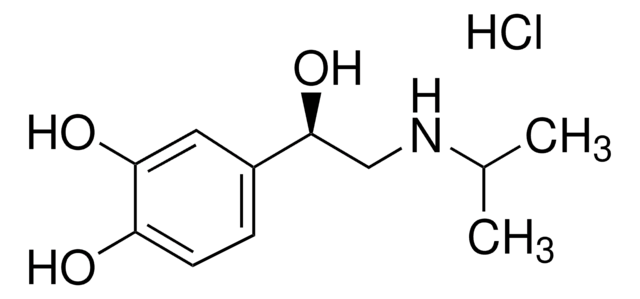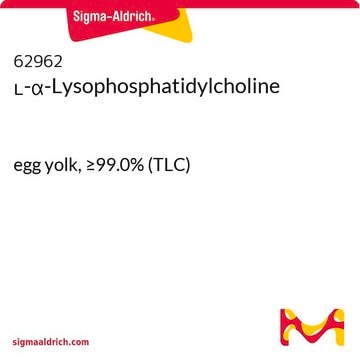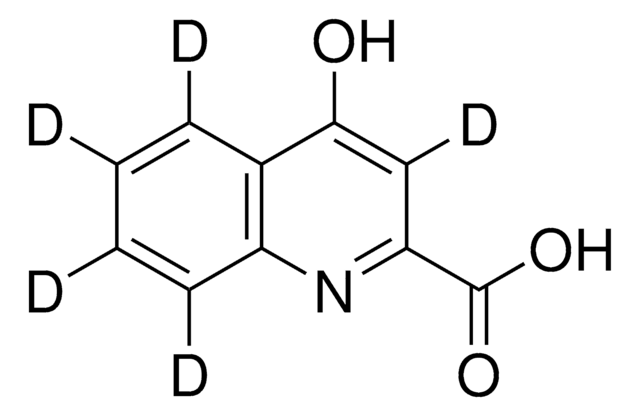L1381
L-α-Lysophosphatidylcholine from bovine brain
≥99%, Type V
Sinonimo/i:
1-Acyl-sn-glycero-3-phosphocholine, L-α-Lysolecithin
Autenticatiper visualizzare i prezzi riservati alla tua organizzazione & contrattuali
About This Item
Prodotti consigliati
Descrizione
zwitterionic
Tipo
Type V
Saggio
≥99%
Tipo di lipide
phospholipids
Temperatura di conservazione
−20°C
Descrizione generale
L-α-Lysophosphatidylcholine is a major plasma lipid, derived from phosphatidylcholines that includes glycerol and sphingoid based lipids with one fatty acid. It is an important cell signaling molecule for G-protein coupled receptors.
Applicazioni
L-α-Lysophosphatidylcholine from bovine brain has been used:
- to determine the dose-dependent high-mobility group box 1 (HMGB1) release in macrophage and monocyte cultures by production of lysophosphatidylcholine (LPC)
- for lysolecithin demyelination of mice brain tissue
- for demyelination of axons
Azioni biochim/fisiol
L-α-Lysophosphatidylcholine possess cytotoxic effects and is present at high level in ischemia and atherosclerotic aortas.
Lysophosphatidylcholine is a major component of oxidized low density lipoproteins, and has been implicated in various inflammatory reactions, including atherosclerosis. It is a degradation product of phosphatidylcholine by phospholipase A and has cytolytic properties. The product is used to demyelinate spinal neurons and study the processes underlying remyelination. It activates protein kinase C, p38 MAP kinase, p42 MAP Kinase, and the jun kinase (JNK) pathway, and stimulates transcription of c-jun. Lysophosphatidylcholine accumulates during cardiac ischemia and may induce arrhythmias by uncoupling gap junction communication, and increase ischemic damage by enhancing Na+ loading in cardiac myocytes. It also activates TREK1, TREK2 and TRAAK K+ channels.
Caratteristiche e vantaggi
This compound is featured on the Phospholipase D page of the Handbook of Receptor Classification and Signal Transduction. To browse other handbook pages, click here.
Altre note
Contains primarily palmitic, stearic and oleic acids.
Codice della classe di stoccaggio
11 - Combustible Solids
Classe di pericolosità dell'acqua (WGK)
WGK 3
Punto d’infiammabilità (°F)
Not applicable
Punto d’infiammabilità (°C)
Not applicable
Dispositivi di protezione individuale
Eyeshields, Gloves, type N95 (US)
Certificati d'analisi (COA)
Cerca il Certificati d'analisi (COA) digitando il numero di lotto/batch corrispondente. I numeri di lotto o di batch sono stampati sull'etichetta dei prodotti dopo la parola ‘Lotto’ o ‘Batch’.
Possiedi già questo prodotto?
I documenti relativi ai prodotti acquistati recentemente sono disponibili nell’Archivio dei documenti.
I clienti hanno visto anche
Suppression of HMGB1 release by stearoyl lysophosphatidylcholine:an additional mechanism for its therapeutic effects in experimental sepsis
Chen G, et al.
Journal of Lipid Research, 46(4), 623-627 (2005)
Metabolism and atherogenic disease association of lysophosphatidylcholine
Schmitz G and Ruebsaamen K
Atherosclerosis, 208(1), 10-18 (2010)
Human induced pluripotent stem cells differentiation into oligodendrocyte progenitors and transplantation in a rat model of optic chiasm demyelination
Pouya A, et al.
PLoS ONE, 6(11), e27925-e27925 (2011)
Myelin regulatory factor drives remyelination in multiple sclerosis
Duncan GJ, et al.
Acta neuropathologica, 134(3), 403-422 (2017)
Yuan Wang et al.
Oncotarget, 7(32), 50937-50951 (2016-07-30)
The earlier study showed that lysophosphatidylcholine (lysoPC) induced apoptosis in human coronary artery smooth muscle cells (SMCs); however, the related molecular mechanisms are not fully understood. The present study investigated how lysoPC induces apoptosis in cultured human coronary artery SMCs
Il team dei nostri ricercatori vanta grande esperienza in tutte le aree della ricerca quali Life Science, scienza dei materiali, sintesi chimica, cromatografia, discipline analitiche, ecc..
Contatta l'Assistenza Tecnica.














